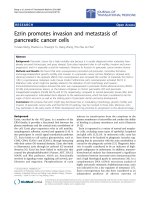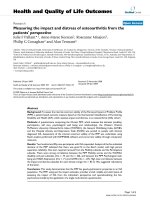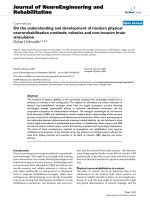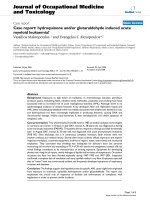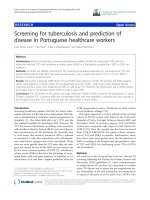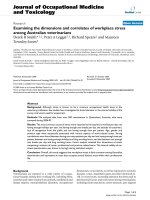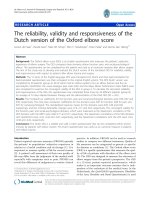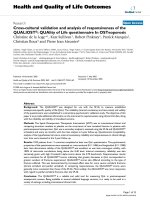Báo cáo hóa học: "One-Pot Green Synthesis and Bioapplication of L-ArginineCapped Superparamagnetic Fe3O4 Nanoparticles" doc
Bạn đang xem bản rút gọn của tài liệu. Xem và tải ngay bản đầy đủ của tài liệu tại đây (396.09 KB, 6 trang )
NANO EXPRESS
One-Pot Green Synthesis and Bioapplication of L-Arginine-
Capped Superparamagnetic Fe
3
O
4
Nanoparticles
Yongchao Lai
•
Weiwei Yin
•
Jinting Liu
•
Rimo Xi
•
Jinhua Zhan
Received: 14 September 2009 / Accepted: 28 October 2009 / Published online: 13 November 2009
Ó to the authors 2009
Abstract Water-soluble L-arginine-capped Fe
3
O
4
nano-
particles were synthesized using a one-pot and green
method. Nontoxic, renewable and inexpensive reagents
including FeCl
3
, L-arginine, glycerol and water were cho-
sen as raw materials. Fe
3
O
4
nanoparticles show different
dispersive states in acidic and alkaline solutions for the two
distinct forms of surface binding
L-arginine. Powder X-ray
diffraction and X-ray photoelectron spectroscopy were
used to identify the structure of Fe
3
O
4
nanocrystals. The
products behave like superparamagnetism at room tem-
perature with saturation magnetization of 49.9 emu g
-1
and negligible remanence or coercivity. In the presence of
1-ethyl-3-(dimethylaminopropyl) carbodiimide hydrochlo-
ride, the anti-chloramphenicol monoclonal antibodies were
connected to the
L-arginine-capped magnetite nanoparti-
cles. The as-prepared conjugates could be used in immu-
nomagnetic assay.
Keywords Magnetite Á Superparamagnetic Á
Solvothermal Á Amino acid Á Nanocrystals
Introduction
In the last decade, inherently safer nanomaterials and
nanostructured devices were widely fabricated with the
‘‘green chemistry’’ principles [1–13]. It is important to
design synthetic methodologies that possess the minimi-
zation or even total elimination toxicity to the environment
and human health in green chemistry [1, 14]. The nontoxic,
renewable raw materials and environmentally benign sol-
vents are generally considered in a green synthetic strategy
[1]. As society and environment can benefit from the
products, green chemistry can convey a responsible attitude
to public toward the development of nanoscience and
nanotechnology [14].
Magnetite (Fe
3
O
4
) nanoparticles have attracted intensive
interests for a wide range of fields, including magnetic
fluids, immobilization of proteins, peptides and enzymes,
immunoassays, drug or gene delivery magnetic resonance
imaging, data storage, environmental remediation [15–25].
The Fe
3
O
4
nanoparticles perform best in most of biome-
dicinal applications when the size of the nanoparticles is
around 10–20 nm. In this range, an individual nanoparticle
becomes a single magnetic domain and shows superpara-
magnetic behavior above blocking temperature [26, 27].
Large numbers of methods have been developed for the
synthesis of high-quality Fe
3
O
4
nanoparticles of various
surface modifier based on the thermal decomposition of
iron organometallic compounds in a high-boiling point
organic solvent [28–37]. When those magnetite nanopar-
ticles are applied in biomedical fields, surface post-treat-
ments are usually needed.
In the present work, we described a facile and green
approach toward synthesis and stabilization of Fe
3
O
4
nanoparticles. Water and glycerol were used as environ-
mentally benign solvents in the synthesis. Inartificial amino
Electronic supplementary material The online version of this
article (doi:10.1007/s11671-009-9480-x) contains supplementary
material, which is available to authorized users.
Y. Lai Á W. Yin Á J. Liu Á R. Xi Á J. Zhan (&)
Key Laboratory for Colloid & Interface Chemistry of Education
Ministry, Department of Chemistry, Shandong University,
250100 Jinan, People’s Republic of China
e-mail:
R. Xi
College of Pharmaceutical Sciences, Nankai University,
300071 Tianjin, People’s Republic of China
123
Nanoscale Res Lett (2010) 5:302–307
DOI 10.1007/s11671-009-9480-x
acid L-arginine was chosen as the nontoxic, renewable
stabilizing agent.
Experimental Section
Materials
Chloramphenicol (CAP) and 1-ethyl-3-(dimethylamino-
propyl) carbodiimide hydrochloride (EDC) were purchased
from Sigma–Aldrich. o-Phenylenediamine (OPD) was
purchased from Xinjingke Biotechnology. Hydrogen per-
oxide (30%) was supplied by Guangmang Chemical Co.
The anti-CAP monoclonal antibody and HRP-CAP conju-
gates were produced by our lab. Other analytical grade
chemicals were purchased from Shanghai Chemical
Reagents Company. All of the chemicals were used as
received without further purification.
Buffers and solutions used were listed below:
a. Phosphate-buffered saline (PBS): 138 mM NaCl,
1.5 mM KH
2
PO
4
, 8 mM Na
2
HPO
4
ÁH
2
O and 2.7 mM
KCl, pH = 7.4.
b. Washing buffer (PBST): PBS containing 0.05 (v/v)
Tween 20.
c. Citrate buffer: 19 mM citric acid, 33.5 mM Na
2
H-
PO
4
ÁH
2
O, pH = 5.0
d. Substrate solution: 5 mg OPD, 12.5 mL citrate buffer,
2.5 lLH
2
O
2
(30%).
e. Stopping solution: 2 N HCl.
Synthesis of
L-Arginine-Capped Fe
3
O
4
Nanoparticles
L-Arginine (3.0 g) and FeCl
3
(0.5 g) were added to a
component solvent containing glycerol (10 mL) and water
(10 mL). A transparent solution formed through sonication
of this mixture. This solution was transferred into a Teflon-
lined stainless steel autoclave with a capacity of 50 mL and
maintained at 200°C for 6 h. Then, the autoclave was
cooled to room temperature naturally. The product was
washed with distilled water to remove residue of solvent
and unbound
L-arginine, finally dried by vacuum freeze-
desiccation technology before characterization. During
each step, the product was separated from the suspension
by magnetic force.
Preparation of Magnetic Nanoparticles Conjugates
A solution was formed by mixing 250 lLFe
3
O
4
nano-
particles suspension and 1 mL phosphate-buffered saline
(PBS). Then, 10 lL of anti-CAP monoclonal antibody and
1 mg of 1-ethyl-3-(dimethylaminopropyl) carbodiimide
hydrochloride (EDC) were added. Afterward, the mixture
was incubated overnight with light shaking at room tem-
perature. Excess EDC and the supernatant were removed
by magnetic separation, and the precipitate was washed
three times with PBS. Antibody-labeled magnetic nano-
particles were redispersed in PBS (1 mL) and stored at 4°C
for use.
Immunomagnetic Assay
The above store suspension (100 lL) was added to a tube
and rinsed three times with washing buffer (PBST) in a
magnetic field. Then, 100 lL conjugates of chloramphen-
icol and horseradish peroxidase (CAP-HRP) were injected.
The incubation was performed for 2 h at room temperature
with constant shaking. The sample was washed three times
with PBST as earlier. Substrate solution (100 lL) was
added, and the reaction was kept for 15 min. Finally,
stopping solution (2 N HCl) was used to stop the reaction,
and the absorbance was determined at 492 nm. A com-
parative experiment was performed just replaced mag-
netic nanoparticles conjugates with unlabeled magnetic
nanoparticles.
Characterization
XRD patterns were recorded on the X-ray diffractometer
(Bruker D8) with a graphite monochromator and Cu Ka
radiation (k = 1.5418 A
˚
) in the range of 10–80° at room
temperature. The morphology of the products was deter-
mined with transmission electron microscopy (JEM-
100CXII) with an accelerating voltage of 80 kV. The
nanocrystals dispersed in water were cast onto a carbon-
coated copper grid. Magnetization measurements of the
nanocomposites were performed with a Micromag 2900 at
room temperature under ambient atmosphere. X-ray pho-
toelectron spectra (XPS) were measured with X-Ray pho-
toelectron spectroscopy XPS (ESCALAB 250). Enzyme
immunoassay (ELISA) was performed with an automatic
microplate reader KHB ST-360 from Shanghai Zhihua
Medical Instrument Ltd.
Results and Discussion
Black products were prepared via a one-step solvothermal
method.
L-Arginine, an alkaline amino acid with guanidino
group, was served as capped reagent in this reaction. The
crystallinity and phase purity were determined by powder
X-ray diffraction (XRD) as shown in supporting informa-
tion. All diffraction peaks could be assigned to inverse
spinel Fe
3
O
4
phase (JCPDS card 19-0629). No other crys-
talline impurity was detected. The lattice constant calcu-
lated from this pattern was 8.389 A
˚
, which is very close to
Nanoscale Res Lett (2010) 5:302–307 303
123
the reported value. A representative TEM image of L-argi-
nine-capped Fe
3
O
4
nanoparticles dispersed in acidic solu-
tion is shown in Fig. 1a, which indicates that Fe
3
O
4
nanoparticles have an average diameter of 13 nm. The high-
resolution transmission electron microscopy (HRTEM)
image (Fig. 1b) suggests the crystalline nature of Fe
3
O
4
nanoparticles with a clearly resolved lattice spacing of
around 0.483 nm, corresponding to that of (111) of inverse
spinel Fe
3
O
4
crystal. All the spots of Fourier transformed
pattern (Fig. 1c) obtained from the HRTEM image in
Fig. 1b can be indexed as those peculiar to the 01
"
1½zone
axis of face centered cubic Fe
3
O
4
.
X-ray photoelectron spectroscopy (XPS) was used to
further confirm the products. From spectra in Fig. 2a, the
peaks of the C 1 s, O 2p, N 1 s, Fe 3p and Fe 2p indicate
the
L-arginine molecules are located on the surface of
Fe
3
O
4
nanoparticles. In Fig. 2b, Fe 2p
3/2
and Fe 2p
1/2
double peaks correspond to binding energies of 710.55 and
723.70 eV, respectively. The double peaks are broadened
due to the appearance of Fe
2?
(2p
3/2
) and Fe
2?
(2p
1/2
), in
agreement with the literature that the peaks broaden for
Fe
3
O
4
on the appearance of Fe
2?
(2p
3/2
) and Fe
2?
(2p
1/2
)
[38, 39]. This phenomenon confirms the product is Fe
3
O
4
rather than c-Fe
2
O
3
. As is shown in the magnetic hysteresis
loop of
L-arginine-capped Fe
3
O
4
nanoparticles (Fig. 3), the
nanocrystals behave with superparamagnetism at room
temperature with saturation magnetization of 49.9 emu g
-1
and negligible remanence or coercivity.
The different dispersing state of Fe
3
O
4
nanoparticles in
acidic and alkaline solutions can be clearly observed by
naked eye, as shown by the supporting information Fig. S2.
Fe
3
O
4
nanoparticles dispersed in an alkaline solution
completely precipitated in a few minutes, while they are
stable in an acidic solution for at least 1 month and could be
moved by a magnet just like ferrofluid. When the suspen-
sions were filtrated with 0.45 lm filtration membrane, we
got colorless and transparent liquid as Fe
3
O
4
nanoparticles
could not pass filtration membrane in alkaline solution. On
the other hand, black and homogeneous solution was col-
lected in acidic solution.
L-Arginine is an inartificial amino
acid. The amino group and the acid group could exist in the
form of ammonium ions and carboxylate ions, respectively,
under certain conditions [40]. It has been reported that both
amine and acid groups are able to attach onto iron oxide
surface [17, 25]. When the guanidino group of
L-arginine
attaches onto the surface of iron oxide, the nanoparticles are
expected to have distinct states in solutions with differ-
ent pH value. Although the isoelectric point (pI) of pure
L-arginine is 10.76 [40], the isoelectric point is expected
to change for the attachment of the guanidino group in
L-
_arginine to Fe
3
O
4
nanoparticles. The new isoelectric point
Fig. 1 a TEM image of the Fe
3
O
4
nanocrystal. b HRTEM image of
single Fe
3
O
4
nanoparticle c FFT of HRTEM image in (b)
304 Nanoscale Res Lett (2010) 5:302–307
123
will be the average of the pKa of the carboxylic acid group
and the pK
b
of the amine group [40] and therefore, ca. 5.61.
As illustrated in Scheme 1, in an acidic solution, the
L-arginine molecules exist in the cationic form due to the
formation of ammonium ions. These ammonium ions may
prevent formation of hydrogen bonds between Fe
3
O
4
nanoparticles. In an alkaline solution, surface-bound
L-arginine molecules are negatively charged due to the
formation of carboxylate ions which readily form hydrogen
bonds with surface-bound amine groups of neighboring
Fe
3
O
4
nanoparticles. This phenomenon is similar to the case
of lysine-capped gold nanoparticles [41].
To demonstrate potential biomedical applications of
L-arginine-capped Fe
3
O
4
nanoparticles, magnetite nano-
particles were bioconjugated with anti-CAP monoclonal
antibody to form the immunomagnetic beads (IMB) via the
classical EDC activation [42, 43]. Then, they are used in
the immunological test. The result showed that the mixture
containing anti-CAP monoclonal antibody-labeled mag-
netic nanoparticles had a deep yellow color (Fig. 4 right)
after color development, and the absorbance was 2.113,
while the comparative one had no obvious color change
2.0x10
4
4.0x10
4
6.0x10
4
Fe
2+
Counts / s
Bindin
g
Ener
gy
/eV
Fe
2+
Fe
3+
Fe
3+
b
725 720 715 710 705
1200 900 600 300 0
0.0
5.0x10
5
1.0x10
6
1.5x10
6
Counts / s
Binding Energy /eV
Fe 3p
C 1s
N 1s
O 1s
Fe 2p
Fe (A)
O (A)
a
430 420 410 400 390 380 370
N 1s
Fig. 2 a The XPS of the L-arginine-capped Fe
3
O
4
nanoparticles.
Evidence for the existence of
L-arginine coating can be found. b The
details of the Fe 2p
1/2
and Fe 2p
3/2
peaks
-15000 -10000 -5000 0 5000 10000 15000
-50
-25
0
25
50
M/emm
⋅g
-1
H/Oe
Fig. 3 Magnetic hysteresis loop measured at room temperature for
the
L-arginine-capped Fe
3
O
4
nanoparticles. The NPs show superpara-
magnetic properties at room temperature, and the Ms is about
49.9 emu g
-1
pH 3
pH
10
Hydrogen bond
Amido
Carboxyl
Guanidino
Fe
3
O
4
nanoparticles
NH
2
OH
O
H
NH
2
N
NH
Scheme 1 Illustration of the assembly of dispersed L-arginine-
capped Fe
3
O
4
nanoparticles in water at different pH values. The
inset is the structure of
L-arginine
Fig. 4 Photographs of color development of unlabeled (left) and
antibody-labeled (right) magnetic nanoparticles
Nanoscale Res Lett (2010) 5:302–307 305
123
(Fig. 4 left) at the same time and the absorbance was 0.065.
It was suggested that
L-arginine-capped Fe
3
O
4
nanoparti-
cles were successfully attached to the anti-CAP monoclo-
nal antibody.
Conclusions
We have synthesized
L-arginine-capped superparamagnetic
Fe
3
O
4
nanoparticles via a simple and green method in
water and glycerol component solvent. The synthesized
Fe
3
O
4
nanoparticles have an average diameter of 13 nm
and the saturation magnetization reaches to 49.9 emu g
-1
with negligible remanence or coercivity. With superpara-
magnetic properties and the active groups on the surface of
the nanoparticles, their application for magnetic separation
and concentration in immunoassays were further demon-
strated. These products are expected to have more exten-
sive applications in biomedical fields.
Acknowledgments Financial support from the Program for New
Century Excellent Talents in University (NCET-06-0586), the Key
Project of Chinese Ministry of Education (No. 109098), and the
National Basic Research Program of China (973 Program
2005CB623601, 2007CB936602) is gratefully acknowledged. Prof.
Xi acknowledges the financial support from the National Natural
Science Foundation of China (No. 20675048), the National High-
Tech Research and Developmental Program of China (863 Program,
No. 07AA10Z435 and 2007AA06A407).
References
1. P.T. Anastas, J.C. Warner, Green Chemistry: Theory and Prac-
tice (Oxford university Press Inc, New York, 1998)
2. A.S. Matlack, Introduction to Green Chemistry (Marcel Decker,
New York, 2001)
3. P. Raveendran, J. Fu, S.L. Wallen, J. Am. Chem. Soc. 125, 13940
(2003). doi:10.1021/ja029267j
4. P. Raveendran, J. Fu, S.L. Wallen, Green Chem. 8, 34 (2006).
doi:10.1039/b512540e
5. B. Hu, S.B. Wang, K. Wang, M. Zhang, S.H. Yu, J. Phys. Chem.
C. 112, 11169 (2008). doi:10.1021/jp801267j
6. S.S. Shankar, A. Rai, B. Ankamwar, A. Singh, A. Ahmad, M.
Sastry, Nat. Mater. 3, 482 (2004). doi:10.1038/nmat1152
7. J.P. Xie, J.Y. Lee, D.I.C. Wang, Y.P. Ting, Small 3, 672 (2007).
doi:10.1002/smll.200600612
8. Y. Wang, S. Maksimuk, R. Shen, H. Yang, Green Chem. 9, 1051
(2007). doi:10.1039/b618933d
9. P. Mukherjee, A. Ahmad, D. Mandal, S. Senapati, S.R. Sainkar,
M.I. Khan, R. Parishcha, P.V. Ajaykumar, M. Alam, R. Kumar,
M. Sastry, Nano Lett. 1, 515 (2001). doi:10.1021/nl0155274
10. Y. Saito, J.J. Wang, D.A. Smith, D.N. Batchelder, Langmuir 18,
2959 (2002). doi:10.1021/la011554y
11. P. Mukherjee, A. Ahmad, D. Mandal, S. Senapati, S.R. Sainkar,
M.I. Khan, R. Parishcha, P.V. Ajaykumar, M. Alam, R. Kumar,
M. Sastry, Angew. Chem. Int. Ed. 40, 3585 (2001). doi:
10.1002/1521-3773(20011001)40:19\3585:AID-ANIE3585[3.0.
CO;2-K
12. J.H. Yang, L.H. Lu, H.S. Wang, W.D. Shi, H.J. Zhang, Cryst.
Growth Des. 6, 2155 (2006). doi:10.1021/cg060143i
13. M.N. Nadagouda, R.S. Varma, Green Chem. 8, 516 (2006). doi:
10.1039/b601271j
14. A.D. Jennifer, L.S.M. Bettye, E.H. James, Chem. Rev. 107, 2228
(2007). doi:10.1021/cr050943k
15. T. Neuberger, B. Scho
¨
pf, H. Hofmann, M. Hofmann, B.J. von
Rechenberg, J. Magn. Magn. Mater. 293, 483 (2005). doi:
10.1016/j.jmmm.2005.01.064
16. J.F. Liu, Z.S. Zhao, G.B. Jiang, Environ. Sci. Technol. 42, 6949
(2008). doi:10.1021/es800924c
17. L.Y. Wang, J. Bao, L. Wang, F. Zhang, Y.D. Li, Chem. Eur. J.
12, 6341 (2006). doi:10.1002/chem.200501334
18. C. Xu, K. Xu, H. Gu, X. Zhong, Z. Guo, R. Zheng, X. Zhang, B.
Xu, J. Am. Chem. Soc. 126, 3392 (2004). doi:10.1021/ja031776d
19. X. Jia, D.R. Chen, X.L. Jiao, S.M. Zhai, Chem. Commun. 8, 968
(2009). doi:10.1039/b813524j
20. Q.X. Shi, R.W. Lu, K. Jin, Z.X. Zhang, D.F. Zhao, Green Chem.
8
, 868 (2006). doi:10.1039/b606705k
21. A. Dyal, K. Loos, M. Noto, S.W. Chang, C. Spagnoli, K.V.P.M.
Shafi, A. Ulman, M. Cowman, R.A. Gross, J. Am. Chem. Soc.
125, 1684 (2003). doi:10.1021/ja021223n
22. T. Mirzabekov, H. Kontos, M. Farzan, W. Marasco, J. Sodroski,
Nat. Biotechnol. 18, 649 (2000). doi:10.1038/76501
23. J. Won, M. Kim, Y.W. Yi, Y.H. Kim, N. Jung, T.K. Kim, Science
309, 121 (2005). doi:10.1126/science.1112869
24. M. Kotani, T. Koike, K. Yamaguchi, N. Mizuno, Green Chem. 8,
735 (2006). doi:10.1039/b603204d
25. J.P. Ge, Y.X. Hu, M. Biasini, C.L. Dong, J.H. Guo, W.P. Be-
yermann, Y.D. Yin, Chem. Eur. J. 13, 7153 (2007). doi:
10.1002/chem.200700375
26. A.H. Lu, E.L. Salabas, F. Schu
¨
th, Angew. Chem. Int. Ed. 46,
1222 (2007). doi:10.1002/anie.200602866
27. V.K. Varadan, L.F. Chen, J.N. Xie, Nanomedicine: Design and
Applications of Magnetic Nanomaterials (Nanosensors and
Nanosystems John Wiley & Sons, Ltd New York, 2008)
28. S.H. Sun, H. Zeng, D.B. Robinson, S. Raoux, P.M. Rice, S.X.
Wang, G.X. Li, J. Am. Chem. Soc. 126, 273 (2004). doi:
10.1021/ja0380852
29. S.H. Sun, H. Zeng, J. Am. Chem. Soc. 124, 8204 (2002). doi:
10.1021/ja026501x
30. Z.C. Xu, C.M. Shen, Y.L. Hou, H.J. Gao, S.H. Sun, Chem. Mater.
21, 1778 (2009). doi:10.1021/cm802978z
31. N.R. Jana, Y.F. Chen, X.G. Peng, Chem. Mater. 16, 3931 (2004).
doi:10.1021/cm049221k
32. X.W. Teng, H. Yang, J. Am. Chem. Soc. 125, 14559 (2003). doi:
10.1021/ja0376700
33. J. Park, K. An, Y. Hwang, J.G. Park, H.J. Noh, J.Y. Kim, J.H.
Park, N.M. Hwang, T. Hyeon, Nat. Mater. 3, 891 (2004). doi:
10.1038/nmat1251
34. S. Peng, S.H. Sun, Angew. Chem. Int. Ed. 46, 4155 (2007). doi:
10.1002/anie.200700677
35. E.V. Shevchenko, D.V. Talapin, N.A. Kotov, S. O
0
Brien, C.B.
Murray, Nature 439, 55 (2006). doi:10.1038/nature04414
36. F.Q. Hu, L. Wei, Z. Zhou, Y.L. Ran, Z. Li, M.Y. Gao, Adv.
Mater. 18, 2553 (2006). doi:10.1002/adma.200600385
37. C. Hui, C.M. Shen, T.Z. Yang, L.H. Bao, J.F. Tian, H. Ding, C.
Li, H.J. Gao, J. Phys. Chem. C. 112, 11336 (2008). doi:
10.1021/jp801632p
38. C.C. Pamela, A.H. Richard, R.F. Denise, Lippincotts Illustrated
Reviews: Biochemistry (Lippincott Williams & Wilkins, Phila-
delphia, 2008)
39. W. Temesghen, P.M.A. Sherwood, Anal. Bioanal. Chem. 373,
601 (2002). doi:10.1007/s00216-002-1362-3
40. Z. Li, H. Chen, H.B. Bao, M.Y. Gao, Chem. Mater. 16, 1391
(2004). doi:10.1021/cm035346y
306 Nanoscale Res Lett (2010) 5:302–307
123
41. P.R. Selvakannan, S. Mandal, S. Phadtare, R. Pasricha, M. Sastry,
Langmuir 19, 3545 (2003). doi:10.1021/la026906v
42. W.L. Shelver, L.M. Kamp, J.L. Church, F.M. Rubio, J. Agric.
Food Chem. 55, 3758 (2007). doi:10.1021/jf0632841
43. C.S. Hottenstein, S.W. Jourdan, M.C. Hayes, F.M. Rubio, D.P.
Herzog, T.S. Lawruk, Environ. Sci. Technol. 29, 2754 (1995).
doi:10.1021/es00011a009
Nanoscale Res Lett (2010) 5:302–307 307
123
